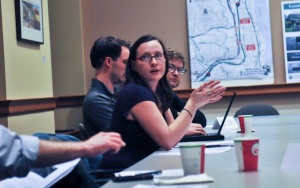
bike advisory committee meeting last week.
(Photo © J. Maus/BikePortland)
Pressure is mounting for the Oregon Department of Transportation (ODOT) to consider a road diet on SW Barbur Blvd but the agency seems unwilling to even seriously consider the idea. Neighborhood activists, the Bicycle Transportation Alliance, the Portland Bureau of Transportation, and a growing list of advocacy groups and organizations want Barbur to have safer and more pleasant bike access and they feel now is the time to do it. ODOT is about to spend $5 million to rehabilitate two bridge structures on Barbur (at Vermont and Newbury streets), but current plans call for no significant bike access improvements.
ODOT’s Region 1 Transit and Active Transportation Liaison Jessica Horning (read our profile of her when she was hired in November) and their bike/ped coordinator Basil Christopher presented the project to the PBOT Bicycle Advisory Committee last week.
Barbur has four lanes and standard-width bike lanes for most of its length. Auto speeds average about 55 mph, so bicycling is unpleasant and only for the strong and fearless. At the Vermont and Newbury bridges, conditions get even worse as the bike lanes suddenly drop and the road narrows. At the BAC meeting last week, ODOT showed a proposal that would increase the width of the existing sidewalk and heighten the railing on the west (southbound) side. That side is slightly uphill, so ODOT feels like widening the sidewalk from three to five feet would allow some people to bike up onto it and get out of the road.
That tiny change is the only thing being proposed by ODOT in this project. Not surprisingly, BAC members were not impressed.

There is support from community activists and others to make larger changes. Specifically, many people want ODOT to consider re-allocating space to create room for a wider, protected bike lane.
On December 24th the BTA published a blog post by SW Portland activist and BTA volunteer Keith Liden titled, Imagine a Pedestrian and Bicycle Friendly Barbur Boulevard. In making the case for a Barbur road diet, Liden wrote:
“Barbur Boulevard has enormous potential to be a primary bicycle route between downtown and southwest Portland because it is the most direct route with a moderate grade. Enhancing the existing bike lanes and providing bike lanes on the Newbury and Vermont bridges would remove the primary obstacles to bicycling on this important route.”
Just yesterday, the BTA published a letter of support for the road diet from Lewis & Clark College Sustainability Council.
But ODOT reps say there’s no funding for such ideas, that a road diet would require lengthy public process and further analysis and it would be outside the scope of their bridge rehab project. Instead, says Jessica Horning, the place to discuss the road diet idea is in Metro’s SW Corridor planning process. But while advocates are pushing for changes in the short-term, the SW Corridor plan is a visioning process that isn’t expected to result in concrete projects for 10-20 years (if ever).
When Horning asked the BAC for feedback on the project as it stands today (with only the sidewalk widened by two feet), committee member Matt Arnold said, “I don’t know that your proposed improvements mean anything for bikes. Widen the sidewalk and call it a pedestrian improvement. Sure, go ahead; but don’t call it a bike improvement. We wouldn’t support them because there are no real improvements. We have to start looking at some of these other options.”
BAC Chair Ian Stude also supports doing something now. He told Horning that, “The idea of delaying is not appealing,” and used the example of the recently completed NE Multnomah project in the Lloyd District. That project was completed quickly, and without a lengthy public process.
Support for a road diet on Barbur also came in from City of Portland Planning Commissioner and PortlandTransport.com founder Chris Smith. Speaking as a concerned citizen and not in an official capacity, he told the committee, “I ride this corridor about once every two weeks and I would very much support the road diet.”
In response to an inquiry about a road diet by Keith Liden in 2011, ODOT said (among other things) that their 2035 traffic projections show they need all four auto lanes in order to handle future traffic demand. But Smith pointed out that the City’s planning goals foresee an opposite future. “The City’s Climate Action Plan and the Portland Plan aspire to a dramatic lowering of vehicle miles traveled,” he said, “And the regional vehicle miles traveled is already declining. I’d like us to build what we aspire to, not to what we’re afraid of.”
Even a Portland Bureau of Transportation staffer piled onto ODOT’s reluctance to consider a road diet. City Bike Coordinator Roger Geller said he’d never even considered a road diet on Barbur until recently, “But it should have been obvious.” Geller went on to say he’s heard from an ODOT traffic engineer that they are concerned how a road diet might impact emergency evacuation routes. “He also noted that there’s been no bike crashes on this section so he appears to be saying this is a safe road,” Geller added, “I just wonder what the philosophy is at ODOT around this.”
Then Geller made ODOT a somewhat bold proposition. “Why don’t you guys put forward a road diet proposal and then give us the money to do the analysis for you? We’ve got a lot more experience than ODOT at doing road diets.” Geller said an analysis would only cost about $2,000. “I think the idea of waiting for the SW Corridor project as a way to analyze the whole corridor is missing the most important point… That those bridges are terrifying. It [a road diet] just seems like such a simple opportunity to improve conditions dramatically.”
Even with all this support for taking a more serious look at doing a road diet, Horning, the ODOT rep, didn’t budge. She continued to refer the discussion to the SW Corridor process. In a follow up email after the meeting, she wrote,
“We think it makes more sense to consider a road diet, or any other major changes to the corridor, as part of the corridor planning process we are already underway with. The Vermont/Newbury Bridges project has provided a good catalyst for this discussion, but it is a Bridge Preservation funded project to repair the bridges so that they are not weight restricted to TriMet buses, and the use of these funds is restricted to certain types of activities… I know there is frustration with the timeline, but I think that this is the most effective way to move a proposal like this forward and to determine what can be done both in the short and long term.”
For their part, the BAC drafted a letter to ODOT (PDF) which again urged them to take up the road diet idea. Here’s an excerpt (emphases mine):
“Given the scarcity of available, bicycle-friendly routes connecting Southwest Portland with the Central City and Northwest… the need for bicycle-appropriate safety improvements on these bridges is paramount… With its gentle grade and direct alignment, this segment of Barbur holds tremendous potential to be the premier bicycle route connecting downtown and Southwest Portland. It is critically important for ODOT to find an acceptable and comprehensive solution to the current safety issues now and not use the SW Corridor or other planning initiatives as a rationale to defer serious action until well into the future.
Therefore, the BAC strongly recommends that ODOT partner with the City of Portland to immediately conduct a full and modally balanced evaluation of a road diet between SW Hamilton and SW Miles. Then, should an analysis of a road diet indicate that dropping a travel lane would still allow the roadway to function properly, the two agencies should work together to design appropriate bicycle and pedestrian facilities that reflect the importance of this route for non-automotive transportation and that will accommodate the increase of bicycle and pedestrian travel expected for Portland’s future. Our committee would very much welcome the opportunity to be involved with such efforts.”
As behind-the-scenes talks continue on this road diet idea, one of the frustrations is simply ODOT’s reluctance to be flexible and creative when it comes to making Barbur work better for biking and walking. The historically auto-focused agency has made many statements lately that they’ve turned over a new leaf and now believe fully that the future means different decisions must be made about how we design roads. Their reluctance to embrace the Barbur road diet flies in the face of that rhetoric.
Stay tuned.
Questions and comments about this project can be emailed to ODOT Community Affairs Coordinator Jilayne Jordan via Jilayne.Jordan@odot.state.or.us.


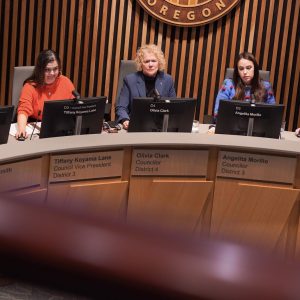
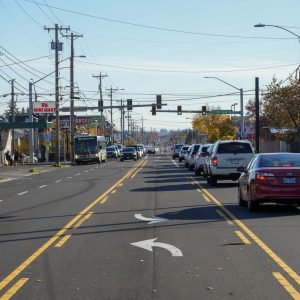
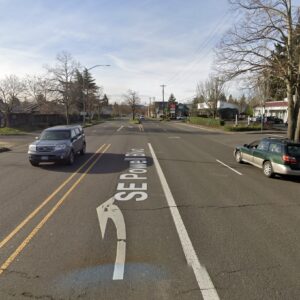
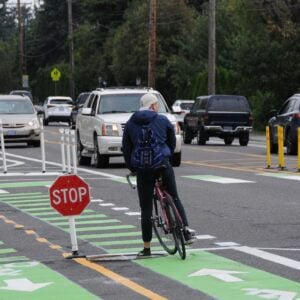
Thanks for reading.
BikePortland has served this community with independent community journalism since 2005. We rely on subscriptions from readers like you to survive. Your financial support is vital in keeping this valuable resource alive and well.
Please subscribe today to strengthen and expand our work.
ODOT — or the people who work there now — will be buried by the very near future. Dinosaurs.
Is that a threat? Because the new bike/ped lady is young enough to live for several more decades.
Sigh.
“they need all four auto lanes in order to handle future traffic demand.”
Why do we keep hearing this? Where do these folks learn to say this in answer to every sensible question? How can we teach them a different tune? This is getting ridiculous.
And meanwhile, they’re ignoring current bicycle demand. Why don’t we reconfigure the lanes today, and have the conversion about future traffic needs later, when it actually becomes a problem.
Wasn’t there recently something about state law possibly saying ODOT *can’t* reduce lane capacity? I seem to recall some talk about that.
If we are thinking of the same thing I believe it was called hole-in-the-air or something like that and it came from our friends in the trucking assoc.
http://bikeportland.org/2012/06/14/advocates-help-push-back-alarming-freight-power-grab-in-salem-73270
Last year ODOT said they couldn’t change their plans to include a cycle track on Sandy Boulevard. Just what is their process for including public feedback and new ideas?
http://bikeportland.org/2012/09/11/odot-sandy-blvd-and-the-curse-of-outdated-design-manuals-76315
What is utterly distressing to me about their stance here is that they seem to be unable to view the future of transportation in any other way than an extrapolation of 20th Century trends. But viewed from a statistical perspective (have late 20th C trends held over the past decade? NO) as well as a policy perspective (is this a direction we as a state/a region wish to go in? NO, see Climate Action Plan, Oregon Global Warming Commission Task Force Report, Peak Oil Task Force Report, Oregon Ten Year Energy Plan, etc.) not to mention a pragmatic, prudent perspective (can we afford as a society to continue increasing the number of cars every year? NO).
Their reflexive cars first, cars last, we don’t recognize anything but cars stance is a threat to the state’s future and the livability of our region.
What can be done?
When all you’ve been trained to do is swing a hammer, everything looks like a nail.
ODOT = Same old same old
I just emailed Ms. Jordan my comments. I rode this route every day for nearly three years, and will be back at it when I go back to work. I am one of the 9% of bike commuters who are women, and there will never be more of us (let alone more cyclers, period) until Barbur feels more like a bike route and less like a death trap.
This seems like fairly typical ODOT behavior to me. I have interacted with them numerous times in a professional capacity. They pay lip service to things like multi-modal transportation, environmental complliance etc., and even hire staff like Ms. Horning to perpetuate the illusion that they take these matters seriously. The truth is that the road building and maintenance engineers and staff hold all the power in the agency and these people believe that nothing should affect/limit how they build and maintain roads, which are for motor vehicles only. I’ve been dealing with ODOT for 15 years and I am sad to say that I have seen nothing to indicate that culture is changing.
The solution to this Barbur problem is obvious: it needs to be disqualified as an official “corridor”.
My first though would be to have a 3rd party safety study done on this segment to refute the alleged safety of this corridor.
I mean, ODOT must think it is safe for all users or they would be in violation of some deep dark part of their charter about not endangering the public.
The 85th percentile thing seems like a good place to start; does that 85% actually stay in the speed range that ODOT believes it does?
Does ODOT have accurate injury and fatality rates for this and other segments of road under its jurisdiction? If so can we show that this segment is more dangerous and has exacted a larger human toll in exchange for expediency?
I like the idea of declaring a state of emergency on this section of Barbur due to its recorded dangers and declassifying it as a corridor, as a highway and removing it from ODOT’s jurisdiction.
I have a proposal, recalibrate DOT to determine road wear in Bicycle Units of Wear (BUW) A bicycle unit of wear is a 350 lb GVW bicycle, for standardization purposes only (bicycles come in many different GVW but a standard road bike with a commuter and gear, food, etc comes to about 350 GVW). A Smart FourTwo has 1100 BUW, a Cadillac Escalade has 8000, a semi loaded to 20 tons GVW has 10,000,000 BUW, and a semi loaded to the full DOT limit of 40 tons has 160,000,000 BUW. For every 13K bikes that replace SOV SUVs you get 1 extra semi at half the legal limit weight. Then they might see the light without the application of a clue-by-four to the forehead.
I love the idea of a Barbur road diet, but only if it does not have a negative impact on future transit operations. A 2- or 3-lane cross-section would kill any chance for Bus Rapid Transit dedicated lanes in the corridor. ODOT may have a point that this should wait for SW Corridor planning to be complete. That said, perhaps lane widths could be reduced to at least allow for wider bike lanes that are continuous.
If they configure it with two southbound lanes, and one northbound, that would leave the option to convert one southbound lane to a peak-direction BRT lane.
“emergency evacuation routes”…Really?! Looking at BTA’s rendering, there are still three lanes available for auto traffic to evacuate (not to mention alternate routes such as I5). Given a scenario where those three lanes are filled to capacity, it seems to me it would be a benefit to have the bike lane available and not clogged with cars, either for bikes/pedestrians who might well be moving faster than the traffic jam, or for emergency use by authorities.
In an actual evacuation traffic would flow in only one direction, and a properly executed evacuation would have emergency personnel directing that traffic to utilize all available lanes, regardless of ‘standard’ direction of travel. This is what’s done on coastal islands on the east coast (like the Outer Banks) during hurricane evacuations.
I think the whole evacuation route argument is pretty ironic as I understand that even after the bridge retrofit those vidaucts will still crumble in case of a major earthquake. And if they don’t crumble the Capitol Hwy ramp will.
Sure, of course it would be one-way, that’s why I said “three lanes available” in the BTA image. A fourth lane would make very little, or no, difference in throughput in such an evacuation route since the limiting factors would be input and output. Then, instead of providing near-static vehicle stacking, that fourth lane could be used more valuably for evacuating non-motorized vehicles and/or moving the emergency personnel you mention through the area, even possibly in a counter-flow capacity. As both Hurricane Sandy and Portland’s disaster bike trials have demonstrated, people with non-motorized vehicles have a significant role to play in such a disaster scenario.
I agree with Barbara, the evacuation excuse is a big stretch by ODOT. Besides the structural problems, and besides alternate routes like I-5, Macadam and some smaller routes, the unknowns, unpredictables and “fog of war” in such an event will overrun the best laid plans. Since unknowns will inevitably happen, why not design this flexibility in the evacuation system? I’m not buying that excuse.
Over a decade back I would bike this way to work daily…for about five years. These bridges and the Barbur Bl bike lanes are what turned me into the confident city/ hill rider I have become since they are terrifying. Two added feet to that uphill cement sidewalk creature would be a nice, but only the tiniest step, since that is what I used to do during traffic and it was scary. I would just wait for a gap in traffic going downhill and ride ass fast as I could…. a road diet is REALLY needed between SW Miles and Hamilton…and here is another reason why.
It is the closest I have ever come to being flattened.
I was riding home after dark since I worked swing. I passed the two bridge bottle necks and swung past the Capital highway off-ramp going downhill at a very good speed in the bike lane and then I was hit and fell off my bike….wham. A tree limb (a big one) had fallen over the cement guard barrier and was protruding three feet into the lane at head height…..I did not see it until I hit the pavement. Luckily I always wear a helmet….my first thought was “get the hell out of the road” since this is a stretch with poor auto visibility due to the curve and speeds surpassing 60 MPH…..so I grabbed my bike and jumped back into the bike lane ..two seconds later a started driver speeding around the curve would have run right over me.
I then limped to Hamilton and called my friend to meet me downtown with a new pair of pants. Luckily I was not hurt except for being REALLY sore the next few days….but the point remains. A nice WIDER buffered bike lane would be a wonderful idea and a road diet is REALLY needed here.
They could do the modelling really fast, it would not cost much to stripe and if in 10 years we need the extra lane for BRT or other reasons then we can talk about bike bridge by-passes.
I also e-mailed my story to her. Maybe a personal story of near death will make ODOT understand that this stretch of bike lanes are simply to narrow and dangerous and need to be fixed.
We really need some sharp bike lawyers that will start suing ODOT/the city. The big pipe was only built thanks to some environmental lawyers and it seems like one of the few things large organizations like ODOT listen to. That’s the sort of thing I’d like the BTA to start funding. Clearly we’re not getting much from them as just part of the public process.
Seriously, what is the point of “fixing” the bridge if they’re not going to come close to doing it correctly. What a waste of money!
I don’t get it. It seems everybody but ODOT is pushing for a road diet. A road diet could be done really cheaply with just some paint for lane restriping and maybe some traffic signs. They could even call it a trial and then see if they need to adjust it later as lane stripes are nothing permanent. So if we got Rapid Bus transit later or traffic hell breaks loose in 50 years they can adjust again. Or maybe by then we have the enviable problem of Copenhagen where they have bike traffic jams.
I also emailed my comments to ODOT.
That sounds like a really good first step, a reasonable compromise.
I think delaying action here to the SW Corridor planning process is missing the point. The issue is safety NOW. A road diet is a short term solution while SW Corridor project can be long term solution. Perhaps SW corridor creates an even better parallel bike facility and uses Barbur primarily for transit/auto. Who knows.. but a road diet now is a easy and relatively inexpensive fix that will help keep us moving in the right direction toward our climate action goals. How much does ODOT value life? $2-3 million? A road diet can probably be done for far less and avoid at least one potentially fatal collision due to existing substandard conditions.
“ODOT is about to spend $5 million to rehabilitate two bridge structures on Barbur (at Vermont and Newbury streets), but current plans call for no significant bike access improvements.”
I fully support the road diet approach and think that it’s an essential first step towards encouraging the “interested but concerned” in SW.
But as a fairly regular (at least in the summer) “enthused and confident” rider of Barbur, I disagree strongly that the Vermont/Newbury bridge improvements don’t represent “significant bike access improvements.” When I ride home from Beaverton on a route that takes me down Barbur, those two bridges are BY FAR the part of the route that I significantly dread, and one of the primary reasons I won’t ride that way in the winter.
Those improvements might seem like token gestures compared to what we’d like to see, or to those who don’t regularly ride there, or to the “interested but concerned’ (and probably many of the “enthused and confident”) who won’t ride Barbur no matter what, but I for one do NOT find them insignificant. I am very much looking forward to the change.
Also, point of clarification: while speeds of 55mph are sadly not uncommon Barbur, I think it’s a pretty big exaggeration to say that average speeds are 55mph. Besides riding it in the summer, I drive Barbur several times a week year-round (usually at speeds closer to 35mph) and I would judge the average speed to be closer to 45mph.
Interesting. I guess it boils down to
(a) adequate, all things considered, vs
(b) if they’re spending $5M on this stretch, by any measure of fairness not to mention trends toward bikes and away from car dependence they should seize the opportunity to do more, make it abundantly clear that this is not the old ODOT but a new forward looking, responsive, fiscally responsible agency that has its eyes wide open.
P.S. Is anyone else having trouble posting comments here lately? The size of the comment box has shrunk to three lines of text. I now consistently have to click two or three times to get the comment to register as a reply. And once my comment just went poof (and I don’t mean it gets stuck in moderation). Maybe it’s my computer, but I thought I’d ask.
P.S. Is anyone else having trouble posting comments here lately?
For quite awhile now, yes, although the 3-line editing box is newer (and unpleasant). It’s not only posting comments (which in some cases never completes, although the post does appear upon page reload) but the response time of page loads in general is slow. No big complaint, just FYI.
The triangle of dots in the lower right of the comment box allows you to expand the size of the comment area–just be careful you don’t drag the right edge of it outside the larger comment area or the dots get clipped and you can’t drag it back again. If that happens, the right edge of your text will be hidden as well. I also notice that clicks on [Reply] buttons on comments are triggering a page reload sometimes, which they didn’t used to do.
On a mobile browser: not seeing or ever have seen these dots .
And recently the reply button not only forces a page reload but after reload it dumps me at the comment box but doesn’t show any indication that I am replying to anyone.
I then have to go back up and hit the same reply button again. This forces another page reload as before but the comment box now shows that I am replying to a comment.
ODOT must do more for Barbur Blvd. Bicyclist safety can be improved within the $5 million being budgeted and needs to be. Access to downtown from Barbur has been difficult for decades. Let’s please fix it now because these bridges on Barbur are indeed the major safety concern for bikes. A wider sidewalk is an improvement but also a lost opportunity if more is not done. The new ODOT needs to be a better and smarter ODOT. Let’s keep pushing this.
BTA should have made this less about access from South Portland to the central city and more about access from the west-side suburbs and the central city. People from Tigard and Beaverton go downtown by bike, and people downtown go to Tigard and Beaverton by bike.
C’mon, BTA, be the “ALL OREGON” bike advocacy group you claim to be.
Glow Boy:
According to ODOT: The average 85th % speed on this segment of Barbur is 55 mph.
“According to ODOT: The average 85th % speed on this segment of Barbur is 55 mph.”
This is really interesting, Roger. Do you have a reference for this?